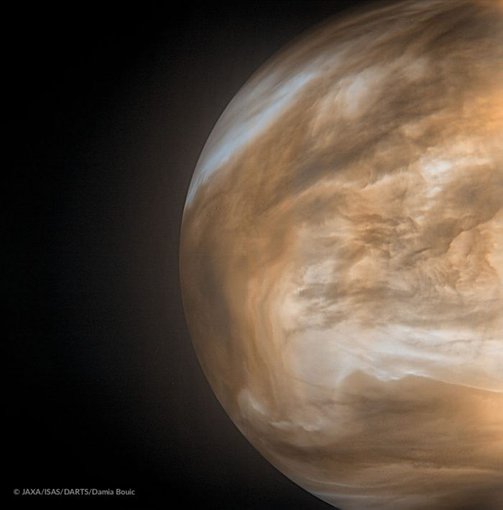*This post may contain affiliate links. This means we may make a commission if you purchase an item using one of our links*
The main differences between Venus and Ganymede is that Venus is a terrestrial planet that orbits the Sun whilst Ganymede is a natural satellite that orbits Jupiter, Venus’ day is 243 days in length whilst a Ganymede day is 7 days and Ganymede is the biggest moon in our solar system whilst Venus is the 2nd biggest terrestrial planet and 6th biggest planet overall.
There are numerous other differences between these two celestial bodies so continue reading for a more thorough breakdown of each entity below.
What Is The Planet Venus?
Table of Contents

Venus is the 2nd closest planet to the Sun and is often regarded as Earth’s sister planet. It’s very close to our Earth in size where its diameter is 12,104km. This is just over 600km less wide than our home planet.
Unlike all the planets further outside the Sun’s orbit, Venus and even mercury have no moons orbiting it. The most probable reason for this is due to its closer proximity to it, which means that smaller objects orbit the Sun as opposed to Venus.
Venus is also the hottest planet in our solar system where its surface temperature is 475 degrees Celsius. This is due to a number of factors, like the thicker atmosphere, close proximity to Sun, the reasons for which have been explained in more detail here.
It’s core is hot too, similar to that of the ice giants and Earth, where it stands at 5,200 degrees Celsius.
As a result of this thicker atmosphere, Venus is also able to reflect a lot more of the light the Sun projects at it, making it both the hottest and brightness planet in our solar system. This is why for the longest time, and even till this day Venus is often referred to as the morning or evening star.
The thicker atmosphere is mostly compromised of carbon dioxide, and thick clouds of sulfuric acid. This does result sulfuric acid rain on the planets surface, which of course is very corrosive.
Being so close to the Sun also mean its orbital cycle is much shorter. It takes Venus 225 days to complete a full cycle, on the contrary a single day is actually longer than this where it takes around 243 days for a full rotation around its axis.
This is partially down to its distance from the Sun and the thick atmosphere surrounding this terrestrial planet. The axial tilt on Venus is also different from the other planets in our solar system where it is practically straight at 3 degrees.
All in all this is certainly one of the most interesting planets in our solar system and in many peoples eyes, could very well have supported life in the past based on how close its shape and size is to that of Earth.
What Is The Moon Ganymede?

Ganymede is the largest of the Galilean moons – and the largest moon in our entire solar system – first discovered on 7th January 1610. The surface of this icy world is frozen and covered by two main types of landscape: young, light regions and old, crater-filled terrain. And these darker areas seem to contain a number of organic materials.
Using the Hubble Space Telescope, astronomers have found evidence of an oxygen-based atmosphere. Still, it is far too thin to support any living organisms that we know of. Based on this, it’s unlikely that Ganymede hosts life as we know it.
Estimates place Ganymede at around 4.5 billion years old (the same age as its planet, Jupiter), and its average distance from the Sun is approximately 778 million km.
Its diameter is 5,268km, making it larger than the planet Mercury. Despite this, Ganymede only possesses half the mass of Mercury, so it is still classified as a low-density object.
Ganymede takes seven days to orbit its planet at an average distance of 665,00km, and the temperature varies from minus 112 to minus 193 degrees Celsius.
Among the fascinating features of this ice moon is its magnetosphere. While many planets possess a magnetosphere, no other moon in our solar system shares this trait.
Measuring the changes in the magnetic fields of Ganymede and Jupiter allowed scientists to predict that salt water lies beneath the surface of this freezing world.
However, this is insufficient to support life when you factor in the other elements of this giant moon. In contrast to Europa, the rocky layer of Ganymede is not directly below the ocean, so life would have a difficult time forming both above and below the ice.
In addition, the thick layer of ice on the moon’s surface would make internal, water-based life challenging for scientists to detect.
Similarities Between Venus And Ganymede
Venus and Ganymede do share a few similarities, which includes the following:
- Both have a hotter central core.
- Both have a rocky, terrestrial surface.
- Both are spherical in shape.
- Neither have rings surrounding them.
- Both are part of the same solar system.
- Neither have other celestial bodies orbiting them.
Differences Between Venus And Ganymede
As for the differences, they include the following:
- Venus is bigger than Ganymede where it has a diameter of 12,104km whilst Ganymede’s diameter is 5,268km, also making it the biggest moon in our solar system.
- Ganymede has a magnetosphere while Venus does not.
- Venus is the most luminous entity in our solar system besides the Sun itself.
- Venus is also the hottest body in our solar system besides the Sun where it’s average temperature is 475 degrees Celsius whilst Ganymede’s is between -112 to -193 degrees Celsius.
- Ganymede is tidally locked to Jupiter whilst Venus isn’t tidally locked to any entity.
- A day on Ganymede takes 7 days whereas a Venus year is actually longer than its orbit around the Sun at 243 days.
- It takes Ganymede 12 years to orbit the Sun and 7 days to orbit Jupiter whereas Venus’ orbit takes 225 days.
- Ganymede orbits Jupiter elliptically whilst Venus orbits the Sun in a circular pattern.
- Venus’ surface is made up of numerous volcanoes and craters whilst the lack of heat means Ganymede’s surface is filled with numerous craters and light grooved terrain.
- Ganymede’s gravity is 1.428 m/s² whilst Venus’ is 8.87 m/s².
- Venus has a density of 5.24 g/cm³ whilst Ganymede has a density of 1.94 g/cm³.
- Venus’ mass is 4.867 × 10^24 kg whilst Ganymede’s mass is 1.4819 x 10^23 kg.
- Venus has an atmosphere roughly 90 times thicker than Earth’s whilst Ganymede’s atmosphere is far thinner in comparison.
- Ganymede has an axial tilt of around 0 – 0.33 degrees whereas Venus’ axial tilt is 3 degrees.
Summary
All in all, despite the few similar features that Ganymede and Venus share from the lack of other objects orbiting them and their general composition, the two are clearly very different from one another.
Whether it be their differences in size, temperature, the bodies that they orbit, their luminosity and more, Venus and Ganymede are very much distinct from one another.

